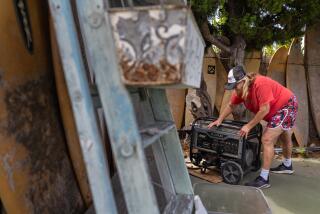Quake Damage Is History at State Park
Loyal Bruno used to cut across what is now Los Encinos State Historic Park when he attended the nearby elementary school, and swim in the warm lake fed by a natural spring.
He remembers the weathered adobe that graced the grounds and the two-story building that looked like it belonged in France, not the middle of Encino.
Bruno, 66, and other residents were unable to enjoy the park for 18 months while it was closed for repairs and restoration of buildings damaged in the Northridge earthquake. But the park at 16756 Moorpark St. was reopened Saturday.
Franciscan missionary and explorer Juan Crespi and his party set up camp by the lakeside in 1769--near what is now Ventura Boulevard and Balboa Avenue--and met with members of the local 200-strong Tongva tribe.
The native people were âvery fine, well-behaved and very friendly,â Crespi wrote in his journal, noting that all but the chief were monogamous--he had two wives.
By the time young Bruno splashed in the lake, it had been reconstructed in the shape of a Spanish guitar and lined with limestone blocks quarried in the Santa Monica Mountains in the 1870s, said park Ranger Russell M. Kimura.
Kimura said work on the parkâs two-story Garnier building and De la Osa adobe was delayed while state officials negotiated with the federal government for $1.2 million to restore the buildings and make them safe.
Inspired by an ancestral home in the south of France, the Garnier building was constructed by the Garnier family, Basque ranchers who also designed the guitar-shaped lake. Kimura has a makeshift office in the building, which has served as everything from a bunkhouse to a brothel.
âThis building is made out of small pieces of limestone,â Kimura said. âItâs even worse than brickwork [in its vulnerability in a quake]. It had three gaping holes in it. It looked like somebody had shot it with a cannon.â
Nels Roselund, the Rosemead-based structural engineer who restored the building, said the job was formidable.
âThe north wall was close to collapsing,â he said. âIt was kind of scary even getting close to it to start working on it. The way it was built, it was just a stack of stones mortared together.â
He and his crew clamped what remained of the wall together, taking care to anchor the corners.
For the reopening, Kimura reinstalled a hands-on exhibit in the Garnier building on the history of the park. It provides a look back to the siteâs incarnation in the 1850s as a longhorn cattle ranch and later as a place where Basque immigrants tended Merino sheep, whose wool was sold in Europe.
Grapevines have been planted next to the building like those that once grew above the veranda of the De la Osa adobe.
âWe were doing tremendous business in the park before the quake,â said Kimura, a ranger at Los Encinos from 1987 until the park closed. (He currently recruits rangers for state parks in Southern California). The shady venue was booked for weddings, film shoots and other events.
Encino residents were frequent visitors. âMost of them were mothers, with their kids, feeding the ducks,â Kimura said.
Now reduced to five acres, the park is the last remnant of a 4,460-acre rancho given to local Indians in the 1830s. The land was bought in 1849 by rancher Vicente de la Osa, who built the adobe and lived in it with his wife and 12 children.
After World War II, locals saved the site from development.
Restoration of the adobe is substantially complete, Kimura said, but it will remain closed until furniture and other damaged artifacts are restored and a new interpretive program is installed.
After the earthquake, the park staff discovered the remains of unusual wall decorations from the Garnier period in one room of the adobe. Frank Preusser, a conservation scientist and consultant in West Hills, said the painted decorations resemble lozenge-like picture frames.
Done in black, gray and ocher, the frame-like shapes surround areas painted to resemble yellow marble. The decorations have been removed from the walls for restoration and possible reinstallation, Preusser said.
The adobe is of great historical interest, according to Edna E. Kimbro, an architectural conservator and historian with the state Department of Parks and Recreation.
âThere are very few surviving adobes,â Kimbro said. California once had more than 1,000, but only about 350 remain.
âAny building that survives from that period is enormously significant,â she said, especially given the growing number of Latinos interested in the stateâs roots.
William Ginell, a senior conservation scientist at the Getty Conservation Institute, described the De la Osa adobeâs restoration as a balancing act.
âItâs important to maintain the authenticity of historic buildings,â he said. âYou should do as little as possible thatâs required to stabilize the structure and prevent damage.â
More to Read
Sign up for Essential California
The most important California stories and recommendations in your inbox every morning.
You may occasionally receive promotional content from the Los Angeles Times.










